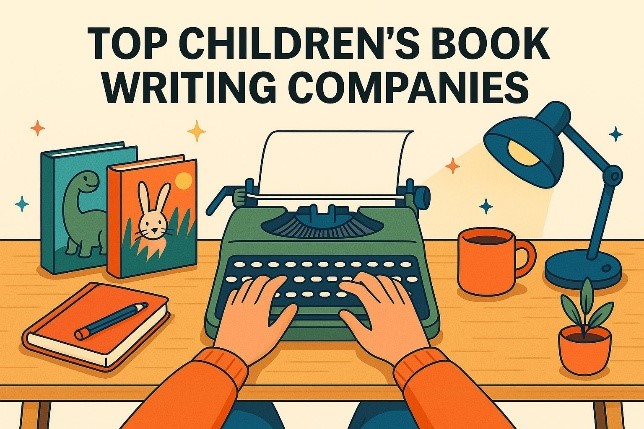Introduction
Writing for children is a joy unlike any other—a delicate blend of whimsy, wonder, and wisdom. In just a few pages, you’re tasked with cracking open a world of dragons, friendship bracelets, or midnight stargazing. Children’s books don’t just entertain; they shape imaginations, nurture empathy, and introduce young minds to the magic of storytelling. But behind every successful story is a support system—editors who understand pacing for short attention spans, illustrators who bring giggles to life, and publishers who know just where these stories belong.
Table of Contents
That’s where the top children’s book writing companies come in. These aren’t just businesses—they’re bridges connecting an author’s heart to a child’s bookshelf. Whether you’re a first-time writer with a fuzzy idea or a seasoned storyteller ready to level up, partnering with the right team can make all the difference. The right writing company becomes your co-pilot, helping you navigate rhyme, rhythm, character arcs, and publishing pitfalls with ease.
In this guide, we’ll explore where to grow, who to know, and how to take your story from dream to doorstep.
Top Children’s Book Writing Companies in 2025
If you’ve ever tried to write a children’s book, you know it’s no small task. You’re balancing heart, humor, pacing, vocabulary levels, and a million little details—all while trying to craft something both delightful and timeless. That’s why many authors turn to professionals who specialize in this magical space. Their services offer a mix of creativity, structure, and industry insight, helping stories leap off the page and into the imaginations of young readers everywhere.
Below, we’re spotlighting some of the best companies in the business—firms that understand the power of a good story and know how to help you tell it just right.
Writers of the West
Writers of the West is a powerhouse with over two decades in the publishing and ghostwriting game. They’ve worked with more than 2,500 authors and helped craft over 200 bestsellers across 14 genres, children’s books included. What makes them one of the top children’s book writing services? It’s the all-in-one approach: writing, editing, illustrations, audiobook production, even global publishing distribution. If you want a partner who’s done it all—and done it well—this team is worth a serious look.
They’re also known for matching authors with genre-specific experts. So if your story is a whimsical tale about a shape-shifting hamster or a heartfelt exploration of a child’s first day at school, they’ll find you a writer who gets your vision.
Storybook Studio
For authors laser-focused on picture books and young adult fiction, Storybook Studio offers tailored services that emphasize developmental editing and fine-tuning voice. They’re small but mighty—every project feels bespoke, with editors and illustrators who genuinely care about the final product.
This company excels at bringing a concept to life in full color, especially when it comes to books that live and breathe through their illustrations. They work closely with authors to understand tone, pacing, and page flow, making sure the story connects with young readers and their grown-up gatekeepers.
If you’re someone who values thoughtful collaboration over a cookie-cutter approach, Storybook Studio might feel like the creative home you’ve been looking for.
WonderWords
WonderWords is one of those firms that feels like it belongs inside a children’s book—playful name, friendly team, and an unmistakable love for storytelling. This full-service company handles everything from story development to illustrations, bringing together a crew of editors, writers, and artists who specialize in the nuances of children’s literature.
They’re especially great at turning big, bold ideas into well-structured books that flow naturally and feel fun to read aloud. Want a main character with a giant pink mustache and a dream to become a detective? They’re on it.
Their art team deserves a special shoutout, too—known for warm, expressive illustrations that enhance stories without overpowering them. If you’re looking for heart and humor in equal measure, WonderWords delivers.
MindStir Media
MindStir Media combines self-publishing expertise with high-quality support. They provide one of the best children’s ghostwriting services and are well known for making the process smooth for authors, from idea to final print. Whether it’s your first book or your fifth, their mentorship model ensures you’re never flying solo.
They’ve helped publish countless children’s books, many of which have gone on to receive awards and praise in the industry. It’s also one of the rare companies that pairs authors with bestselling mentors—professionals who’ve been in your shoes and know what it takes to craft a market-ready manuscript.
While they’re more structured than some of the boutique firms, that’s part of the charm: clear steps, thoughtful feedback, and high production values. If you’re navigating self-publishing and want reliable guidance, MindStir is a name to remember.
Penguin Random House (Imprints & Custom Publishing)
Yes, the publishing giant. Penguin Random House has long been a leader in children’s literature, with imprints like Puffin Books and Random House Books for Young Readers producing some of the most beloved stories of our time. But what you might not know is that they also offer custom publishing services.
This means that if your manuscript meets their standards—or you’re working with a partner who knows how to position it—you may be able to access their world-class design, distribution, and marketing channels. It’s a steeper climb, yes, but the reward is major league exposure.
It’s worth noting: they’re not the place to go if you’re looking for hand-holding. But if you’ve got a polished manuscript and a compelling story, teaming up with an imprint under their umbrella could be a game-changing move.
Scholastic Corporation
You probably know Scholastic from your childhood book fairs (nostalgia, anyone?). But they’re more than just a fond memory—they’re one of the biggest names in educational and children’s publishing today. From early readers to middle-grade novels, Scholastic is in classrooms, libraries, and homes around the world.
They publish thousands of titles each year and have a deep understanding of what resonates with young audiences. Their distribution reach is unmatched, and their editorial teams are top-notch. That said, breaking into Scholastic’s catalog is no small feat. You’ll need a killer manuscript and likely an agent—but it’s a goal worth shooting for.
If you’re working with one of the top children’s ghostwriters, chances are they know how to shape your book into something Scholastic might consider.
Whether you’re aiming high with a traditional powerhouse or want the focused attention of a boutique studio, there’s no shortage of brilliant collaborators in this field. The companies listed here each bring something unique to the table, giving you the tools to tell your story the way it deserves to be told.

Author Communities That Help You Grow
Writing can be a pretty lonely gig—especially when you’re staring at your third version of a sentence and wondering if talking cats are still “in.” That’s why connecting with a supportive community of fellow writers can make all the difference. Whether you’re in the brainstorming stage or polishing your final draft, being part of an author community keeps your energy up and your writing sharp.
SCBWI – Society of Children’s Book Writers and Illustrators
This is basically the mothership for anyone serious about writing or illustrating books for kids. They’ve been around for decades, and their network is massive. One of the best things they offer? Regional critique groups. These let you meet other writers near you (virtually or in-person) and trade feedback. No more asking your cat if your plot twist makes sense.
They also host regional and international conferences that bring together editors, agents, publishers, and seasoned authors. It’s a great way to learn from the pros, pitch your book, find out the best children’s ghostwriting services or just soak up some good creative vibes. SCBWI doesn’t just talk the talk—they’ve helped launch thousands of kidlit careers.
12×12 Picture Book Challenge
The goal here is simple: write one new picture book draft each month for an entire year. It’s like a writing gym for picture book authors. You’ll find webinars, critique groups, writing forums, and a whole lot of cheerleading from people who get what you’re trying to do. The momentum it builds is huge—and the friendships? Even better.
Online Groups and Forums
Facebook groups, Discord servers, and Reddit threads are brimming with author communities that specialize in kidlit. These spaces are perfect for swapping ideas, asking for honest feedback, or just chatting with someone who understands why you’re agonizing over a character’s name.
You’ll also find tips on querying, story structure, marketing, and finding illustrators—and yes, even discussions about the ghostwriting services. The advice tends to be honest, practical, and often experience-based.
Why These Communities Matter
These groups act as both sounding boards and safety nets. Have a question about querying? Someone’s already been through it. Not sure if your rhyme scheme lands? Post a snippet and see what comes back. It’s real-time feedback from people who know your world.
More than anything, communities remind you why you started. When you’re around others chasing the same dream, you feel less like you’re wandering in the dark and more like you’re part of something magical. And once you’re ready to take the next step—maybe partner with one of the top children’s book writing companies—you’ll do so with a support squad cheering you on.
How to Choose the Right Partner for Your Book
So, you’ve got your story idea. Maybe it’s about a moon-cheese explorer or a nervous dragon on their first day of school. The question now is: who’s going to help you bring that vision to life? Choosing the right partner to guide you through writing, editing, illustrating, and publishing your book is one of the biggest decisions you’ll make on your author journey.
What to Look For
When shopping around for support, think like a parent at a parent-teacher conference—curious, hopeful, and a little cautious. You’ll want to evaluate a company’s:
Experience – How long have they been working in children’s publishing?
Specialization – Do they focus on picture books, chapter books, or middle-grade novels?
Portfolio – Have they helped produce books similar in tone or age group to yours?
Testimonials – What do other authors say about them? Bonus points if you spot any success stories in the kidlit world.
A good match feels collaborative, not transactional. You’re not just hiring a service; you’re inviting someone into your imagination.
Full-Service vs. Indie Support
Full-service companies typically offer writing, editing, illustration, formatting, and publishing assistance all under one roof. That’s super helpful if you want a streamlined experience and fewer decisions to juggle.
Indie support, on the other hand, might mean piecing together your own team—hiring a freelance illustrator here, a developmental editor there. It’s more work, sure, but it offers flexibility and may suit authors who like having control over each element of their book.
The Role of Ghostwriters
Some authors know what they want to say but struggle to get it all down in a child-friendly voice. That’s where ghostwriters come in. Especially when it comes to younger age groups, writing for children is its own special art. The top children’s ghostwriters understand how to create rhythm, repetition, and dialogue that sings while keeping vocabulary and pacing just right for little readers.
If you’re collaborating with a ghostwriter, make sure they have experience in children’s literature—and ask to see samples. You want someone who doesn’t just write, but writes with sparkle and sensitivity.
Trust Your Instincts
You’ll know when something feels right. Maybe it’s the way a company responds to your inquiry. Maybe it’s how clearly they lay out the process, or how excited they seem about your idea. The best partnerships are built on mutual respect and shared enthusiasm for the story.
Whether you’re leaning toward freelancers, boutique studios, or one of the top children’s book writing services, take your time and trust your gut. You’re not just picking a service—you’re picking a creative companion to help bring a new story into the world.
Self-Publishing Tools for Children’s Authors
So, you’ve got your manuscript and your character is ready to leap off the page—literally. Now what? Well, welcome to the thrilling, slightly dizzying world of self-publishing. It’s never been easier to take control of your book’s journey, and there are some wonderful platforms ready to help.
Amazon KDP
Let’s start with the big one: Amazon Kindle Direct Publishing (KDP). It’s the reigning champ of self-publishing. It’s free to use, allows for both eBook and print-on-demand options, and gets your book onto the world’s biggest bookstore. That’s a lot of eyes on your talking hedgehog tale.
The dashboard might feel a little techy at first, but once you get the hang of it, it’s smooth sailing. Just remember: you’ll need to prep your manuscript, cover, and metadata before hitting publish.
StoryJumper
StoryJumper is especially loved by schools, teachers, and families because it’s designed with kids in mind. It’s interactive, simple, and even lets children help create books. If you want a DIY vibe and a place to experiment with visuals and layout, this is a gem. Plus, it’s a fun option for author-educators and parents writing personalized stories.
IngramSpark
A little more buttoned-up, but excellent for those looking to get into indie bookstores and libraries. IngramSpark gives you access to a massive global distribution network. They charge small setup fees, but the trade-off is professional-quality printing and serious market reach. In a way, they’re s bit similar to some of the top children’s ghostwriting services that provide printing and global distribution to authors.
The DIY Pros and Cons
Self-publishing gives you total creative control. You pick the illustrator, decide on the font, and choose how much glitter goes on the cover (okay, maybe not glitter, but you get the idea). The upside? Your book is entirely your own.
The downside? Well, it’s a lot. Formatting can be fiddly, marketing takes hustle, and you’ll need a sharp eye for quality. This is where many authors reach out to the ghostwriters—they can get help with everything from story shaping to polishing those final sentences so they shine just right.
Even if you go the self-publishing route, you’re never really alone. You can build a dream team, pulling in freelance editors, illustrators, and marketing whizzes who live and breathe kidlit.
By the time you hold your finished book in your hands—whether you did it all solo or with a full crew—you’ll have brought something truly special into the world. And if you ever decide to partner with one of the top children’s book writing companies down the road, you’ll do so as someone who knows the ropes and isn’t afraid of a little publishing pixie dust.
FAQs: Children’s Book Writing Companies
Navigating the world of top children’s book writing services can feel like stepping into a magical forest—you’re excited, a little nervous, and hoping you’re not about to bump into a troll asking for royalties. Don’t worry—we’ve got you covered. Here are answers to some of the most common questions writers ask before jumping into the publishing adventure.
Q1: Do I keep the rights to my book?
If you’re working with a top children’s book writing services, yes. Most agreements are structured so that once the final payment is made, the author holds 100% of the rights. Still, it’s important to get that promise in writing—read the fine print!
Q2: Do they handle illustrations too?
Absolutely. Many companies either have in-house illustrators or work closely with professionals who specialize in children’s books. If visuals are a big part of your story (and they usually are), make sure to look at sample portfolios before committing.
Q3: How long does it take to publish a children’s book?
Timelines vary depending on complexity. A picture book project can take anywhere from three to nine months from concept to print. If you’re working with multiple professionals—like a writer, editor, and illustrator—build in extra time for collaboration and revisions.
Q4: What if I only have an idea, not a manuscript?
That’s totally fine! Many services offer consultation sessions and story development support. A good company will help you turn that spark into a solid outline, then walk you through the writing process step by step.
Q5: Can I still be involved if I hire a ghostwriter?
Definitely. Many top children’s book writing companies encourage collaboration. You’ll often be asked for input on characters, voice, plot direction—even style and tone. Think of it as co-captaining a very colorful ship.
Conclusion & Next Steps
So here you are—story in hand, imagination fired up, and hopefully a little more confident about what’s ahead. Writing a children’s book might feel like a big leap, but it’s one of the most magical things you can do. You’re not just writing words; you’re building wonder, joy, and tiny adventures that stick with kids forever.
Here’s a simple roadmap: First, learn everything you can. Read blogs, take a course, listen to interviews with authors. Knowledge fuels creativity. Next, find your people. Whether it’s an online forum, a local critique group, or a writing challenge, being around others who love kidlit keeps your momentum strong. Then, decide how much help you want. Maybe you only need editing. Maybe you want to hire one of the top children’s book writing companies. Whatever path you choose, don’t be afraid to ask questions and take your time. There’s no one-size-fits-all when it comes to publishing, especially in the whimsical world of children’s books. But if and when you’re ready, there are many helpful resources out there who can help you bring your story to life—with polish, purpose, and just a touch of pixie dust.











